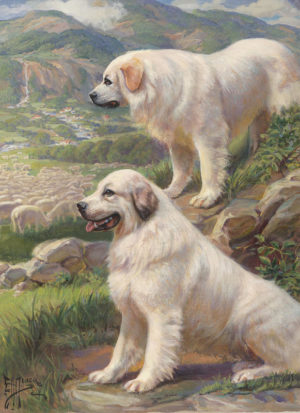
And then there are those posts in which we share something so annoying that you’ll never forget it precisely because it is so annoying. In some circles, this would be considered a mnemonic device. Scroll down when you’re ready:
Back in 2003, kids thought this video by British animator, Jonti “Weebl” Picking was the height of hilarity and played it often enough to where their parents’ ears must have bled.
Ok, it was us.
We were reminded of the video while reading about grey or tan markings on a Great Pyrenees which in French is called “blaireau” after the similar grizzled color mixture color seen in (wait for it) – – – the European badger. This is a mixture of white/grey/brown/black hairs of varying intensity, but the breed standard writes that any markings of gray, badger, reddish brown, or varying shades of tan are acceptable, and they may be of varying sizes appearing on “the ears, head (including a full face mask), tail, and as a few body spots.” When markings exceed one-third of the body, however, they’re considered excessive.
Marked and unmarked all white puppies can be found in the same litter, and indeed, some of the markings on very young pups can be extremely dark brown or even black. With maturity, these tend to fade to gray and tan, and by the age of a year, many of the pup’s markings will have faded to highlights. Some dogs, however, will retain pronounced markings for life.
It’s felt that marked dogs and bitches are important in a breeding program because they help maintain good pigmentation in the breed, something that was realized after generations of all-white to all-white breedings seemed to lead to poor or even missing pigmentation.
Inasmuch as these “marked dogs” have a place in a breeding program, they can be more of a challenge to show in a breed ring if being shown to a judge who isn’t mindful of the optical illusions a face mask can present. The actual shape of the head can be distorted by a mask, so it’s especially important to get one’s hands on the dog.
Legend (from a theoretical standpoint) has it that the marks helped Pyr puppies blend in among the rocks when they were born in the mountains long ago making them less easily found by predators.
Image from the National Geographic

While Gracie (my livestock guardian Great Pyrenees) thinks her tan markings are lovely, as do I….the test if a dog is work, not looks.